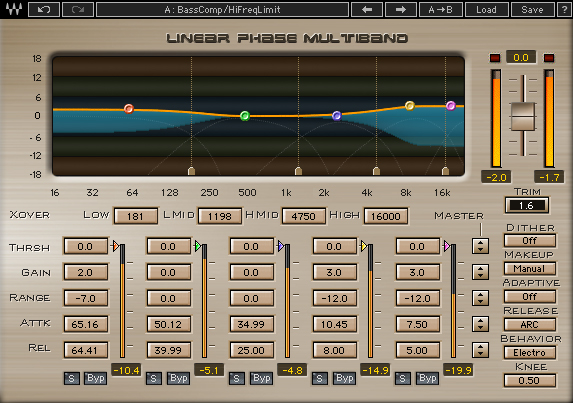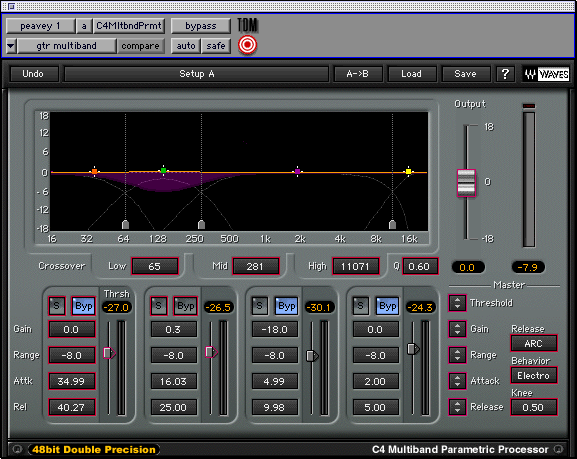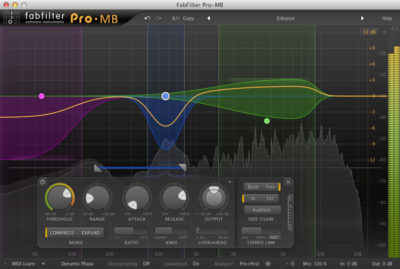Making the Most of Multiband Compression: A Primer on the Safe Use of a Secret Weapon
For many engineers, multiband compressors are daunting tools that are shrouded in mystery. For others, including mixers Tony Maserati, Andy Sneap, and Greg Wells they are like “secret weapons” hiding in plain sight.
Multiband compression is an incredibly powerful tool that is often misused by neophytes. It has the ability to bring just the right amount of energy or control to mix, and the power to completely sap the life out of one as well.
Though it is a fairly complex type of processing, the fundamentals of multiband compression are not difficult to understand. Today, we’ll try to demystify exactly what multiband compression is and how to use it, revealing that there are no real secrets behind this secret weapon at all.
What is Multiband Compression?
Under the hood, a multiband compressor is not a single isolated processor, but rather multiple compressors working separately and simultaneously on different frequency ranges.
Usually, anywhere from 4 to 6 compressors will work side-by-side inside a multiband compressor, processing each portion of the frequency spectrum in parallel.
You can think of a multiband compressor as a set of compressors with an EQ before each one, filtering out frequencies above or below a certain point.
For instance, one of these compressors might follow an EQ that filters out everything below 400 Hz and everything above 1.5 kHz, only clamping down on signal that falls between these two points.
Some multiband compressors use a traditional EQ to filter out signal, which introduces a degree of phase shift that can cause some coloration of the signal near the “crossover” points where two bands overlap.
Many of the multiband compressors to come out in recent years however, such as Fabfilter’s Pro-MB and Waves’ Linear Phase Multiband, use phase linear equalizers, making today’s multiband compressors more transparent than ever before.
Uses and Examples
Multiband compression is one of those tools that can be used on anything, but shouldn’t be used on everything.
Unlike conventional EQ or compression plugins, throwing a multi-band on every track can quickly max out your CPU—and potentially ruin your mix, too. However, in those cases where firing one up makes a lot of sense, it can sometimes be the only tool that will really do the trick.

Multiband compressors allow you to process some bands and exclude others. Sometimes, the best way to use a multiband compressor is to leave some bands turned OFF.
Multiband compressors can be especially useful on drum buses, and even more useful still on a drum stem or loop.
One of the main issues when using conventional compressors on a drum bus is that they can bring out some very undesirable artifacts in cymbals and other high-frequency elements. They can also lead to dizzying “pumping” effects, as low-end build up in a kick drum causes the compressor to clamp down on the whole kit every time it hits.
With multi-band compression however, you can compress the highs and lows separately from the midrange. You could even leave those highs and lows completely unaffected, while still bringing the punch or control of a compressor to bear on the midrange alone.
Alternately, you might use a multiband compressor to control the excesses of a heavy-footed drummer, or a contain the edge of a real cymbal-basher while still allowing you snare drum to poke through.
Another popular trick is to place a multiband compressor in front of a conventional compressor, using the multiband to contain problem frequencies and keep them from disproportionately triggering the next stage of compression.
This general concept translates to an entire mix as well. While classic mix bus compressors are still very useful, a subtle amount of multi-band compression can help keep a lid on problem frequencies, preventing them from getting too far out of control without over-compressing the entire mix.
Too much multiband compression can really suck the life and dynamism out of a track, so it pays to have a light touch. The important thing to listen for with this style of compression is the “movement” of the track, and not just the dynamic range. A properly set multiband compressor can seem to add some “momentum” and “forward movement” to a track instead of just squashing the signal.
While these uses can bring a lot to an bus or stereo mix, some of the best applications of multi-band compression come into play on individual instruments.
One of the most famous examples of this is Andy Sneap’s guitar preset for the Waves C4 multiband compressor. This setting is used to tame the low midrange buildup of heavy, palm-muted guitar without affecting the rest of the tone.

A screenshot of Sneap’s targeted multiband compression for controlling low-mids on heavy palm-muted guitars.
Sneap’s preset helps cut down on the low “flub” that is introduced when guitarists play heavy, palm-muted patterns, by tapping down on just the low resonant frequencies when they become overbearing.
This idea can be applied to just about any kind of guitar recording. All guitar cabinets are going to have their own resonant frequencies, and multiband compression can be used to control some of the most unruly ones. This becomes doubly helpful if the room the amp was recorded in was less than ideal, and adds resonances of its own.
This idea of taming resonances and room modes translates over to another problematic instrument that is often recorded in an open space: The human voice.
One of the many cons of recording vocals in a less-than-ideal environment is that the resonant frequencies of the room can build up and make their way into the microphone. Since the human voice is such a dynamic instrument, most of these resonances cannot be addressed by simply applying static EQ without compromising the tone of the entire vocal track.
This is where multi-band compression comes to the rescue. Not only can multi-band compression reign in some of the stray resonances from the room, but it can also level out the frequency response of a voice as the singer moves through her vocal range or changes inflection. It can also be used to control the kind of midrange “nasality” that may crop up only on certain notes, and even provide targeted de-essing in the high frequencies when needed.
Summing it Up
While multiband compression is as fantastic tool and can be a total lifesaver in some circumstances, it should be used with caution.
Too much multi-band compression can yield you the “smiley face” effect, overly subduing the midrange and sucking the life and energy out of a mix. While frequency analyzers never tell the whole story about your mix, if it looks like The Joker is smiling across your frequency spectrum, you may have gone too far.
It is also important to remember that phase shift is introduced when certain types of multi-band compressors are engaged, potentially changing the tone of the signal—even when no compression is occurring. Many of the modern renditions of these tools have worked very hard to eliminate these issues by employing phase linear EQ filters.
Used this sparingly, multiband impression can improve many mixes. But used haphazardly or overzealously, multi-band compression can lead to all sorts of strange results.
Before engaging a multiband compressor, it is wise to ask yourself: “Why am I engaging this compressor?” Is it to solve problems, by controlling a resonance or a specific problem frequency without affecting others? Is it to keep a particular frequency from triggering compression on the rest of the signal? Or is it to add some “movement” or subtle tonal shaping to an overall mix or instrument group?
By knowing the potential of a multiband compressor, and by going in with your end in mind, you stand a good chance of avoiding pitfalls and getting the most out of your new favorite secret weapon.
Jacob Roach is a writer, producer, and engineer from St. Louis, Missouri.
Please note: When you buy products through links on this page, we may earn an affiliate commission.







